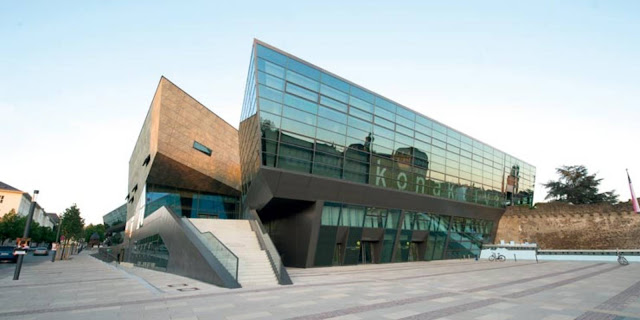The Science and Congress Centre in Darmstadt is a building with a special landmark character, “a central place for the exchange of new ideas and developments as well as scientific findings, for example, in the form of trade fairs, international congresses and meetings,” as Talik Chalabi describes it.
At the same time, however, the “Darmstadtium” serves as a venue for concerts, receptions, cultural and other events. There are 18 conference and seminar rooms, a large foyer area, an underground garage, and a restaurant. In short, this is a multi-functional, modern conference center with a complex spaces meeting the highest of today’s demands towards environmental responsibility, energy-use and stage technic.
Despite the need for storage, loading areas, and access roads, the congress center has apparently no backside; it is transparent and open in all directions. The sloping topography of the plot was used to hide the less attractive supply functions underground.
The building’s direct contacts to the adjacent city centre and university campus are reflected in its interior structures. The new building comprises the congress centre above the ground as well as a two-storey underground car park. Its upper section is divided into several compact building parts. The centrally located foyer in the western section is surrounded by a two-storey seminar area as well as a small hall.
The structure’s 44 500 sqm floor area (480 000 sqfeet) is composed of four interlocking building elements. The masses made of glass, metal and stone house a large auditorium with 1,600 seats and a smaller one with space for approximately 500 people.
The big concert hall in the eastern part is enclosed by further foyers. The 1,800 square metre foyer area can be used for exhibitions. The most important element of the main foyer is a central light funnel that stretches beyond the underground car park into an underground duct and provides the lower storeys with daylight.
The big hall seats a maximum of 1,600 people, but can be split for groups as required. Moreover, the Science and Congress Centre offers 18 conference and seminar rooms for a maximum of 200 people. Here, too, flexibility is key; the individual rooms can be combined as needed.
The restaurant section with a terrace seating approximately 300 people and the directly connected Congress Hotel complements the science and congress centre, which is named after a heavy ion. When choosing building materials, decisions were deliberately made to create an environmentally-friendly and low-energy material set.
Like the high-quality insulated glass that results in low heating costs, or the use of the fastest renewable wooden material, bamboo, as wall and floor finishes. The MEP-design was created with environmental aspects in mind, thus the incorporated engineering solutions (like the vacuum toilet system, the wood-chip heating, or the photovoltaic system) are fulfilling high environmentally-friendly technology standards.
Proving that a successful design process must be universal, the main architectural‚ attraction – the glass and steel flower motif covering the hall – is a very important part of the building‘s engineering systems.
Location: Darmstadt, Germany
Architect: Chalabiarchitects
Landscape: Sommerlad Haase Kuhli
Services:Ebert-Ingenieure / Steinigeweg
Acoustic: Müller BBM
Structural Engineer: Cornelius Schwarz Zeitler
Area: 42.000m²
Cost: 77 Mil. Euro
Year: 2009
Client: City Of Darmstadt + Federal State of Hessen
